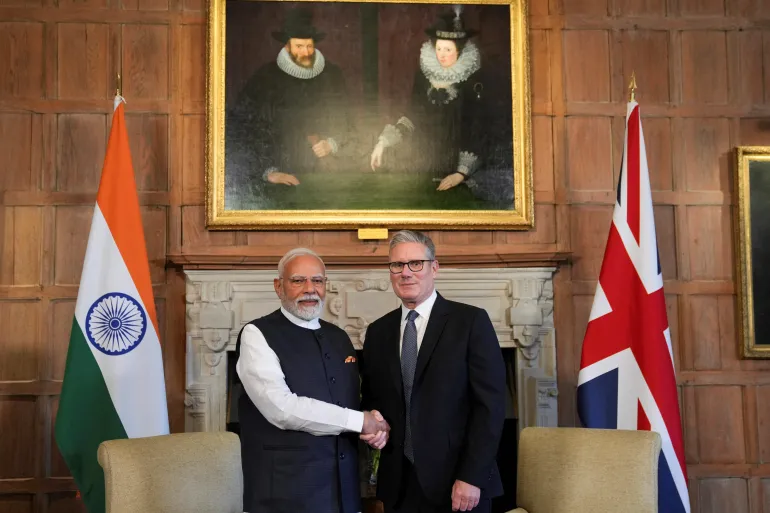On July 24, 2025, India and the United Kingdom officially signed a landmark Free Trade Agreement (FTA) in London, marking a new chapter in their economic relationship. Touted as one of the most comprehensive post-Brexit trade deals, this pact aims to double bilateral trade to $120 billion by 2030 and catalyze job creation, investment, and innovation in both countries. Indian Prime Minister Narendra Modi and UK Prime Minister Keir Starmer heralded the FTA as a “historic milestone” and a “blueprint for long-term economic alignment.”
Key Features of the India-UK Free Trade Agreement
Massive Tariff Reductions and Market Access
-
99% Duty-Free Access for Indian Exports: Almost all Indian exports—encompassing textiles, apparel, gems, jewelry, pharmaceuticals, and agricultural products—now enjoy zero tariffs in the UK. This provides Indian exporters a significant competitive edge in one of their largest markets.
-
Up to 90% Tariff Lines Reduced for UK Exports: The UK will see tariffs slashed from 15% to 3% on average for its goods entering India. Key British exports like cars, spirits (whisky, gin), cosmetics, medical devices, and aerospace products receive immediate and future relief.
-
Flagship Tariff Relief:
-
Whisky tariffs drop from 150% to 75% right away, with a gradual reduction to 40% over 10 years.
-
Automotive tariffs plunge from as high as 110% to 10% under a quota system.
-
Electronics, food, and beauty products from the UK will also become cheaper for Indian consumers.
-
Strategic Economic Gains
-
Bilateral Trade Boost: The deal is projected to inject over £25.5 billion (about $34.5 billion) into annual bilateral trade flows and add £4.8 billion ($6.5 billion) to the UK’s economic output by 2040.
-
Textiles & Apparel: India gains at least 5% more market share in the UK for ready-made garments, home textiles, carpets, and handicrafts thanks to the removal of 10–12% tariffs.
-
Engineering & Pharma: Duty-free access extends to engineering goods and medical devices, with projections to nearly double exports over the next five years.
-
Pharmaceuticals: India’s generic medicine exports to the UK, already its largest European market, are poised for a major surge.
-
Chemicals & Technology: The chemical sector expects 30–40% export growth, while IT services and electronics anticipate 15–20% annual growth under new provisions.
Employment and Social Benefits
-
Labour Mobility: For professionals and workers, the agreement introduces a Double Contribution Convention, enabling portability of social security benefits, making it easier for talent to move across borders.
-
Support for Small Businesses: Clearer customs procedures, digitized trade documentation, and periodic payment options ease entry for SMEs in both markets.
-
Development & Inclusion: For the first time, the FTA incorporates chapters on labour rights, gender equality, and anti-corruption—setting a benchmark for future Indian trade agreements.
What Gets Cheaper for Consumers and Businesses?
-
For Indian buyers: Imported UK goods such as cars, soft drinks, chocolates, spirits, medical equipment, and cosmetics will become more affordable.
-
For UK buyers: Indian products like textiles, ready-to-eat food, engineering equipment, and specialty chemicals see their prices fall and availability rise.
Political and Global Impact
This is India’s first major FTA with a developed economy and the UK’s most ambitious economic pact since Brexit, signaling India’s growing influence in global trade policy. The FTA’s progressive provisions for digital trade, environmental cooperation, and professional mobility are expected to attract new investment and provide a framework for similar deals with the European Union and other regions.
Implementation Timeline
Although signed, the agreement still requires ratification by the UK Parliament. Both governments have expressed confidence it will come into effect within the next year, delivering tangible benefits to exporters, importers, and consumers soon after approval.
What are the most significant sectors expected to benefit from this agreement
Key Sectors Most Likely to Benefit from the India–UK Free Trade Agreement
The India–UK Free Trade Agreement is projected to deliver wide-ranging gains, but certain sectors are poised to see especially significant benefits:
-
Textiles and Apparel: Indian exporters of garments, home textiles, carpets, and handicrafts will gain new market share in the UK thanks to the removal of 10–12% tariffs. The UK’s apparel and fashion retailers will also benefit from greater product diversity and improved price competitiveness.
-
Pharmaceuticals and Medical Devices: India’s thriving pharmaceutical sector, particularly in generic medicines, is expected to experience a major export boost, as the UK is already India’s largest medicine market in Europe. The FTA also enhances access for medical equipment and devices.
-
Engineering Goods and Technology: Indian engineering exports and IT services are expected to benefit from duty-free access and improved terms. Tech and electronics are set for 15–20% annual growth under the deal.
-
Automobiles and Spirits (Alcoholic Beverages): British exporters of cars, whisky, and gin will gain immediate and gradual tariff relief. Automotive tariffs will fall dramatically, while the famously high tariffs on Scotch whisky will be reduced over 10 years, enhancing UK export competitiveness in India.
-
Chemicals: The Indian chemical sector anticipates 30–40% export growth based on improved access and reduced trade barriers.
-
Agricultural Products and Processed Foods: Indian producers gain expanded market access for key exports like spices, tea, coffee, and ready-to-eat products as tariffs drop and UK import procedures are streamlined.
-
Small and Medium Enterprises (SMEs): Both countries’ SMEs will benefit from simplified customs procedures, digital trade documentation, and reduced compliance costs, making it easier to enter and compete in each other’s markets.
-
Professional Services and Labour Mobility: Enhanced provisions for professional services, including mutual recognition of qualifications and easier work visa pathways, will benefit legal, financial, information technology, and consulting firms as well as individual professionals, enabling smoother talent movement.
These sectors are expected to drive much of the estimated increase in bilateral trade, fresh job creation, and investment opportunities, making the agreement a catalyst for broader economic growth and innovation in both India and the UK.
How does the reduction in tariffs influence future business growth for both nations
Reducing tariffs under the India–UK Free Trade Agreement is set to significantly influence the future business growth for both nations in multiple important ways:
1. Boosting Export Competitiveness and Market Access
Lower tariffs make goods and services from both countries more competitive in each other’s markets. For Indian exporters, almost total duty-free access to the UK empowers key sectors like textiles, apparel, pharmaceuticals, and engineering to increase their sales, improve profit margins, and capture new market share. For UK firms—especially those in automotive, spirits, medical devices, and technology—reduced tariffs mean their products become more affordable and attractive to Indian consumers and businesses, opening up India’s vast and rapidly growing middle-class market.
2. Driving Trade Volume and Investment
By reducing or eliminating duties, the FTA is projected to inject billions into bilateral trade flows over the next decade. This increased trade activity prompts companies to expand operations, build new facilities, and hire more people in both countries. Increased certainty and access due to lower tariffs also motivate investors to inject more capital, particularly in sectors where cost barriers previously limited participation.
3. Encouraging Innovation and Diversification
The competitive pressure brought about by increased market access and lower costs pushes firms to innovate, upgrade product quality, and diversify offerings. Indian IT and engineering firms, for example, will have more resources to invest in R&D for the UK market. UK technology and chemical companies can innovate locally with the prospect of easier access to Indian buyers.
4. Job Creation and Skill Development
With exporters scaling operations to meet new demand, job creation is likely in manufacturing, services, logistics, technology, and other sectors. Additionally, labour mobility provisions and mutual recognition of professional qualifications enhance opportunities for skilled workers and encourage businesses to invest in workforce training.
5. Lower Prices and Increased Consumer Choice
Reduced tariffs mean lower costs for importers, leading to lower prices and greater variety for consumers in both India and the UK. This boosts domestic consumption, further expanding business opportunities for retailers and suppliers on both sides.
6. Enabling SMEs and Startups
Small and medium-sized enterprises gain the most from reduced compliance costs and the elimination of regulatory hurdles, empowering them to venture into new export markets and form international partnerships that would have been prohibitively expensive before.
7. Strengthening Strategic Partnerships
The removal of tariff barriers also builds business familiarity and trust, facilitating deeper joint ventures, tech transfers, supply chain collaborations, and cross-border investments—laying the foundation for long-term, sustainable growth beyond merely exporting goods.
Overall, the reduction in tariffs under this agreement is poised to unleash a cycle of export-led growth, greater investment, innovation, and broader economic engagement, driving prosperity for both India and the UK over the coming years.
Conclusion
The India–UK Free Trade Agreement is more than just a tariff-cutting pact. It lays the groundwork for a forward-looking partnership committed to innovation, sustainability, and inclusive growth. Whether you are a business owner, investor, worker, or consumer, the effects of this historic deal will be far-reaching, opening fresh opportunities and driving stronger economic collaboration between two of the world’s fastest-growing large economies.


